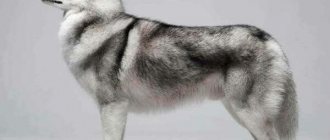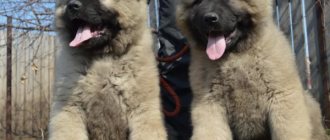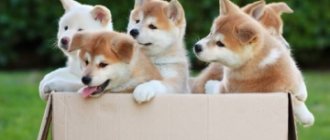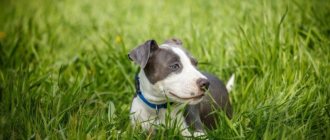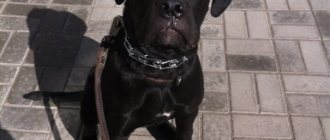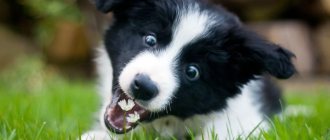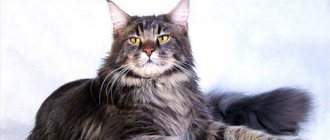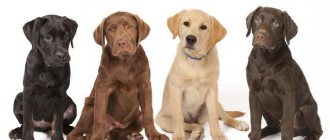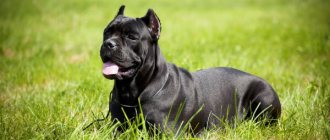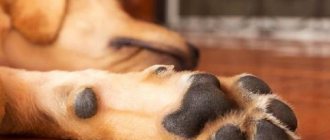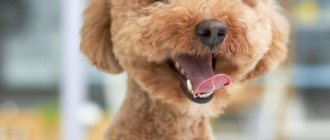The dachshund is one of the ancient hunting breeds, bred specifically for chasing burrowing game. These are independent, smart, brave hunters, good-natured, active, funny four-legged friends and family members.
Caring for a dachshund is simple and within the capabilities of a novice owner. The only thing you should pay close attention to is the dachshund’s nutrition. This is a breed prone to obesity. And excess body weight, especially if gained at a young age, is a source of numerous health problems and a factor that shortens a dog’s life expectancy.
Dachshund weight by month - photos and videos of puppies
The dachshund is one of the ancient hunting breeds, bred specifically for chasing burrowing game.
These are independent, smart, brave hunters, good-natured, active, funny four-legged friends and family members. Caring for a dachshund is simple and within the capabilities of a novice owner. The only thing you should pay close attention to is the dachshund’s nutrition. This is a breed prone to obesity. And excess body weight, especially if gained at a young age, is a source of numerous health problems and a factor that shortens a dog’s life expectancy.
Character
The behavior of a puppy and an adult dog is significantly different.
The hyperactivity and playfulness of babies is complemented by unbearable curiosity and the desire to stick their elongated muzzle into everything. The energy just splashes. Even in their sleep, rabbit dachshund puppies run somewhere, twitching their paws, sniffing out something and yapping. As rabbit dachshunds age, they settle down. A well-mannered adult dog is leisurely, calm, and obedient. Dachshunds that emerge from puppyhood are smart and independent. They even think through the owner's commands in advance. If the dachshund believes that the command is inappropriate, then there is no need to carry it out.
Constant friendliness towards all family members, attention and tact - all this is about the rabbit dachshund. But there is one significant point: dachshunds are very touchy creatures.
The dachshund perfectly remembers insults and injustice against him. Moreover, with all her behavior she will show how upset she is by such circumstances. If the owner does not apologize, most likely, terrible revenge is just around the corner. Dachshunds are good at digging parquet, gnawing furniture and clothing, and biting sensitively.
Rabbit dachshunds don't mind other pets: they enjoy company. It is important to organize the first acquaintance: you will have to carefully ensure that the animals do not harm each other at the first meeting. After this, most likely, the relationship will work out well.
The attitude towards children will be good initially. What happens next depends only on the children. The Dachshund's touchiness and self-esteem need to be taken into account.
The rabbit dachshund does not tolerate loneliness well. She requires either the presence of someone from the family at home, or the company of another pet. If there is neither one nor the other, this will affect the condition of the interior. A bored little dachshund is serious.
Breeders advise choosing nicknames for your dachshund that reflect the cheerful disposition of the breed.
Curiosity and the desire to stick his nose into everything remain in an adult dog, in a milder form. The pet will never refuse a walk, trip, or hike. If the dachshund has enough activity during the day, in the evening he will happily lie on the sofa with everyone, he will be affectionate and happy.
Love of comfort and food are the dog’s weak points. She herself will determine the place for the bed. Absolutely, this will be the warmest place in the apartment, free from drafts. For a favorite treat, the animal is ready to carry out a variety of commands.
Pros and cons of the breed
The rabbit dachshund's diminutive size does not allow it to be a good bodyguard, and it does not have the inclination to do so. But as a pet, the rabbit dachshund is invariably good.
Pros:
- Hassle-free living in the apartment.
- Low maintenance requirements.
- Cleanliness.
- Devotion.
- Friendliness.
- There is no cowardice or excessive aggression.
- Other pets are welcome at home.
- The attitude towards children depends only on the children. The default is excellent.
- Great company for hikes and trips.
- Not a bad watchman.
Minuses:
- A Dachshund's touchiness can cause serious damage.
- Stubbornness or independence - whatever you call it, you will have to negotiate with a dachshund, and not command.
- Education and training require time and moral investment.
- You need to walk a lot with a dachshund. The need for activity and new experiences will have to be satisfied.
- Doesn't tolerate loneliness well.
- The dachshund considers a light bite to be an acceptable method of influencing its owners.
- Tendency to be overweight and high likelihood of spinal problems.
Dachshund weight table by month
The first thing dog owners need to know is that the average weight of dachshunds, miniatures, and standard dachshunds varies. Numbers for adult animals:
- Standard. Boys – 10 kg, girls – 9 kg.
- Dwarf. 4-5.5 kg.
- Rabbit. 2-3 kg.
As for the puppy’s weight, its gain is a consequence of a number of circumstances and factors: individual nuances of development, living environment, physical activity. However, a conscious owner must keep a diary of the development of his dachshund - periodically measure height and weight, enter these indicators and compare them with standard ones.
Below is a table of weights by month for standard dachshunds.
| Age | Weight (kg) |
| 1 Week | 0,2-0,3 |
| 2 week | 0,3-0,7 |
| 3 week | 0,6-1,1 |
| 1 month | 1,1-1,8 |
| 2 months | 2,1-2,9 |
| 3 months | 2,8-4 |
| 4 months | 4,1-5,4 |
| 5 months | 5,6-7,1 |
| 6 months | 7,2-8,5 |
| 7 months | 7,4-8,6 |
| 8 months | 7,4-8,8 |
| 9 months | 7,5-8,8 |
| 10 months | 7,7-9 |
| 11 months | 8,1-9 |
| 1 year | 8,5-9 |
Small deviations from standard indicators are not scary. If the puppy is active, cheerful, growing from month to month, and has an excellent appetite, there is no reason to worry. However, experienced owners advise: “it is better to underfeed a dachshund than to overfeed it.”
Excess weight has a number of negative consequences:
- Additional load on the spinal column. It can lead to both injury and displacement of the vertebrae.
- Diseases of the heart and blood vessels.
To prevent obesity, the first step is to introduce a strict feeding schedule depending on the age of the puppy:
It is important to pay attention to the volume of portions: per 1 kg of dog weight - no more than 40-50 g of food.
For the animal, they choose either premium food (canned food, dry croquettes) or completely natural food. From the 1st month, puppies are offered boiled vegetables and porridge, and from the 4th month - small pieces of lean raw meat.
- Raw or boiled meat (except pork).
- Porridge – buckwheat, rice, oatmeal (semolina is prohibited due to its high calorie content).
- Fermented milk products, cottage cheese (whole milk is prohibited).
- Boiled eggs (no more than 2 times a week).
- Boiled vegetables, raw carrots.
- Fruit pieces – Dachshunds love apples.
Taboos for dogs are treats from the human table, seasoned with spices, salt, sausages, raw fish, confectionery.
In addition to being overweight, the puppy may suffer from dystrophy. This is an equally serious problem that requires a visit to the veterinarian. The reasons for weight loss can be very diverse:
- Insufficient physical activity. If the kitten spends the whole day at home, lying down, he will probably lag behind in development. The young body is recommended for active and long walks, running, swimming, playing with a ball and a “flying saucer”.
- Worm infestation. To prevent infection, the owner monitors the frequency of deworming. The first procedure is 2 months before the first vaccination. If there are clear signs of worms, the medicine is given to very young puppies.
- Wrong menu. If the puppy is eating food, it may be necessary to switch to a higher calorie product. If the diet is natural, you should gradually increase the proportion of foods high in protein and calcium. Moreover, the emphasis is not on animal dishes, but on fermented milk.
- Deficiency of vitamins and mineral elements. Your veterinarian will prescribe the nutritional supplements needed for your specific puppy.
Development in the first month
In the first month, wire-haired dachshund puppies grow very actively. The most important changes by day are presented in the table below.
| Days | Changes |
| 1-3 | Puppies cannot see or hear yet, but they have a developed sense of smell. |
| 4 | The sense of smell increases and hearing begins to appear. |
| 5-7 | The nasal lobe turns dark. |
| 8-9 | Body weight begins to actively increase. |
| 10-14 | The eyes open, the puppy learns to move independently. |
| 15-20 | The first baby teeth appear. |
| 21-30 | The puppies begin to move more and become more active. |
Development and growth rate
Dachshund development, on average, is completed by the 15th month of life. It is at this age that dogs take control measurements. Depending on the type of breed, the animal grows to average parameters:
- Standard. Boys - 22-27 cm at the withers, girls - 20-25 cm.
- Dwarf. Boys - 16-20 cm at the withers, girls - 14-19 cm.
- Rabbit. Boys - 12-15 cm at the withers, girls - 10-13 cm.
For representatives of this breed, it is important to control the volume of the sternum:
- Standard: more than 35 cm.
- Dwarf: 30-35 cm.
- Rabbit: up to 30 cm.
All three species meet the general requirements for the breed:
- The dog should be dense, well-built, graceful - not bulky, but not too puny.
- Boys and girls have well-developed muscles and short but strong legs.
- The Dachshund's chest is generally wider than the loin.
- The tummy is tucked up and has a smooth transition to the sternum.
Dachshunds are “rectangular dogs.” The breed standard requires the following:
- The ratio of height to length is 1:1.7 or 1:1.8.
- Body elongation index – 170-180%.
The first heat in girls is at 8-12 months. But at such a young age, a teenage dog is not ready to reproduce - its body has not had time to get stronger. Why early matings often cause serious health problems. Experts recommend planning mating with a male only after the 3rd heat. Age for first mating:
How to choose a dog: features of breed types
The rabbit dachshund is the smallest dog of this breed.
There are several varieties of dachshunds, each of which has certain characteristics:
- Standard. A small dog 20-25 centimeters high with bright red fur.
- Dwarf. A short dog, whose height is 15-20 centimeters. Weighs no more than six kilograms.
- Rabbit. Grows up to 15 centimeters. The coat is most often colored black.
When choosing a particular type of breed in a nursery, you need to pay attention to the following criteria:
- brand on the right ear or stomach;
- the back is straight, without noticeable sagging;
- ears are rounded;
- the tail is straight, without bends or fractures;
- eyes brown or blue.
The Dachshund is a breed that is popular among dog breeders in Russia. Before getting a pet, you need to familiarize yourself with the characteristics of such dogs, as well as how to care for them.
Factors influencing growth
The development of dogs is influenced by a complex of factors:
- Genetic predisposition, quality of pedigree.
- Keeping a mother dog during pregnancy.
- Quality of mother's milk, duration of feeding.
- Phys. activity. A developing body needs to spend at least 3 hours a day outside. The first walk is a week after the 2nd vaccination. First, the puppy is carried out in warm weather, and over time is taught to walk on a leash or harness.
- Environment. Constant stress, noise, screams, and an alarming environment are extremely negative factors for a puppy. Their consequences range from aggressive behavior to developmental inhibition.
Diseases and their prevention
If the dachshund is not overfed, the dog will practically not develop diseases. It is important to take care of your dog's ears and eyes - inspect them every evening. If your pet is constantly scratching its ears, then it is likely that it could be ear mites - then you need to go to the doctor, who will prescribe drops. The same situation with the eyes - mucus that appears in the corners of the eyes should be removed with a cotton pad soaked in warm water .
What diseases are dachshunds prone to?
The main ailments that can affect your four-legged friend are spinal diseases and osteoporosis (decreased bone density). If you notice that the puppy is limping or his belly is sagging, the dog should be taken to the veterinarian.
Advice! If you notice that your pet's eyes are watery, he is sneezing, he has snot running, he is limping, he is not eating or drinking, he is vomiting, or he is simply inactive for 1-2 days - this is a reason to be wary and immediately take him to the veterinarian. Only a doctor can identify the problem and solve it, keeping the dog healthy.
Vaccinations for dachshund puppies: which ones and when?
Puppies are vaccinated, like other dogs, at 1.5–2 months. The first vaccination will be a vaccine against infectious diseases. After 2-3 weeks they give the 2nd vaccination (polyvalent), after which you can’t walk outside for 2 weeks.
Before the first vaccination (8–10 days), the animal is dewormed. On the day when the puppy is vaccinated, he should be healthy, but if he is sick, then first you need to cure the baby and then vaccinate him. The third vaccination is given when the dachshund is 11–12 months old. Afterwards they are vaccinated annually.
Prevention measures for puppies
The most important point of prevention is the inadmissibility of refusing the second vaccine. It is also important to take pet dogs for vaccinations every year - because without them, the animal is defenseless against such serious diseases as enteritis, viral hepatitis, and rabies.
Photos and videos of puppies
Photos of dachshund puppies at 1 month:
In the photo and video the dachshunds are 6 months old:
Source
Training and education
Rabbit dachshunds immediately understand the beauty of permissiveness, so you will have to raise and train little cunning creatures from the very first day the puppy appears.
There is no doubt that the baby will use all possible means to avoid prohibitions: sad eyes, a hunched back, sadness and sadness will definitely come into play. Do not give in: the rules of behavior must be followed.
Socialization is the first place to start training a small dachshund. It is necessary to familiarize her with the world around her and teach her to react correctly to emerging situations.
The simplest commands are easily learned by the rabbit dachshund, so they are learned in the first months of life.
You cannot hit or shout at a dog . The dachshund will be offended. Calmness and confidence will come in handy when training a rabbit dachshund. The command is not repeated twice, otherwise the dachshund will understand that execution can be postponed. It is recommended to train on an empty stomach.
The Dachshund’s favorite food serves as a great positive motivation. Eating delicious food is her weakness.
Weight and height of a dachshund - how much should it weigh by month, sizes of a puppy and an adult dog
The breed was specially bred for burrow hunting, which becomes more exciting thanks to the courage, intelligence and activity of the dogs. Adult animals are prone to obesity, so their diet is monitored especially carefully. Excess weight in a Dachshund can cause health problems, loss of physical activity and a shortened life expectancy.
Baby teeth and cleaning
Baby teeth appear at three weeks of age. They are sharper than permanent and very fragile. Baby teeth grow completely by 5-6 weeks.
It is not always possible to judge by the bite of baby teeth what a dog's bite will be like . You need to carefully monitor the change of your puppy's teeth, since baby teeth that do not fall out in time can cause the formation of a malocclusion.
To prevent this from happening, you need to give the puppy something hard to chew on, like a carrot. Sometimes a loose baby tooth cannot fall out (especially baby canines) and interferes with the proper growth of permanent teeth.
In this case, they have to be removed. Playing with a puppy with a strong, but not dense rag can help in this matter; this will be the most painless way to remove a “stagnant” tooth .
Permanent teeth begin to replace baby teeth at 12-16 weeks. The process of changing teeth can be very painful for puppies.
The dog is taught to brush its teeth from the age of two months. First, use your own finger, wrapped in several layers of bandage. Apply paste to the bandage and wipe the outside of the teeth.
In the future, you can try using a baby brush . The procedure takes no more than 10 minutes. If the puppy endures the test, he should be rewarded.
How old do dachshunds grow?
Before growing to the standard, the dachshund goes through several stages of development:
- intrauterine – from mating to birth of the puppy;
- suckling – from birth to the end of breastfeeding;
- childhood and adolescence – from 6 weeks to 0.5 years;
- youth – from 0.5 to 1.5 years;
- adult dog - after 1.5 years.
Estrus in females and puberty in males occurs by the age of one year, but this does not mean that they are ready for mating. For breeding, the most suitable age is 2 years. At one and a half years, taxi drivers have a fully formed skeletal and muscular system, so height and weight measurements are carried out during this period.
When they open their eyes
The dachshund is a short dog with a rather unusual physique.
Some people believe that dwarf dachshund puppies are immediately born with their eyes open, but this is far from true. They open only on the 14-15th day after birth. However, they do not open evenly. Most often, only one eye opens at first and after a few days the second one opens.
Mini Dachshund puppies must be protected from bright light sources in the first weeks of life.
How to measure a dachshund?
To measure a dog’s height at the withers at home, proceed according to the following scheme:
- They bring the baby dachshund to the door frame.
- They place it so that the dog does not bulge its back and does not sit on its hind legs.
- Make a notch with a pencil at the level of the upper part of the withers.
- Measurements are taken three times.
- Measure the distance using a metal ruler.
They weigh it using a steelyard, after placing the dog in the bag. In most cases, a dachshund weighs less than 15 kg, so you can pick it up and stand on a bathroom scale. The difference between the obtained and your own indicators will give the weight of the pet.
All measurements should be taken after one and a half years. Normally, standard smooth-haired and long-haired varieties do not look frail or bulky. They have a harmonious build, well-developed muscles, short legs and a chest wider than the waist.
Price of a rabbit dachshund
- The cost of a purebred dachshund rabbit puppy, with all documents and confirmed pedigree, ranges from 30 to 40 thousand rubles.
- If you do not plan to take your dog to exhibitions and competitions, you can find cheaper options. Puppies with deviations from the standard and disqualifying signs seriously lose value.
- For several thousand you can pick up a puppy, but he will not have documents and vaccinations, and there will be no guarantee that this is a rabbit dachshund and not an unknown crossbreed.
Dachshund puppy weight by month
The weight of taxis depends on gender, age, individual characteristics, physical activity, appetite and diet. The table below shows the weight of the dachshund by month. The values are average; the indicators of a particular dachshund may differ, since each puppy develops according to an individual pattern.
| Age | Weight (in g) | ||
| Standard | Dwarf | Rabbit | |
| At 1 month | 1200-1900 | 650-1180 | 380-450 |
| At 2 months | 2050—2750 | 1470-1920 | 770-1000 |
| At 3 months | 2830-3850 | 1880-2530 | 950-1260 |
| At 4 months | 4100-5360 | 2960-3320 | 1350-1840 |
| At 5 months | 5210-7100 | 3220-3850 | 1420-2080 |
| At 6 months | 7250-8540 | 3440-4060 | 1600-2240 |
| At 7 months | 7320-8720 | 3430-4,48 | 1800-2450 |
| At 8 months | 7550-8820 | 3,62-4650 | 2120-2600 |
| At 9 months | 7640-8850 | 3810-5040 | 2300-2800 |
| At 10 months | 7720-9030 | 3900-5150 | 2450-2850 |
| At 11 months | 8150-9140 | 4050-5320 | 2540-2920 |
| At 12 months | 8500-9100 | 4000-5500 | 2550-3000 |
How to toilet train
To toilet train a puppy, you can’t do without a special absorbent diaper..
If the baby ignores the diaper and chooses another place for his needs that is more suitable from his point of view, you need to moisten a piece of cloth in its puddle and place it on the diaper, and wash the place chosen by the puppy with soap and vinegar to eliminate the smell.
The puppy will be guided by the smell, so it is better not to wash the diapers at first. Gradually accustoming your pet to a tray (a special “dog” one with low sides), you need to put his usual diaper in this tray.
If you place the tray in the hallway in front of the front door, then take it outside in front of the dog, you can gradually accustom him to using the toilet outside the house . It can be difficult to train a dachshund to relieve itself outside.
The puppy can endure it until he returns to his usual place home. In this case, a used puppy diaper will help, which you will have to take with you at first. You can also increase the walking time, walk in those places where the pet was able to leave its “marks”.
Dachshund sizes by age
The average weight of an adult standard size dog is 8-9 kg. It depends on the type of dachshund, its gender and age. So, the normal weight of a miniature rabbit dachshund is 2.5-3.5 kg.
| Age | Standard | Dwarf | Rabbit | |||||||||
| Boys | Girls | Boys | Girls | Boys | Girls | |||||||
| weight, g | height, mm | weight, g | height, mm | weight, g | height, mm | weight, g | height, mm | weight, g | height, mm | weight, g | height, mm | |
| At 1 year | 8520-9100 | 220-270 | 7500-8800 | 200-250 | 4000-5500 | 160-210 | 3500-4800 | 152-190 | 2500-3000 | 110-141 | 2000-2410 | 100-132 |
| At 2 years old | 8610-9150 | 230-270 | 7550-8900 | 210-255 | 4000-5600 | 174-210 | 3600-4910 | 161-192 | 2610-3050 | 122-150 | 2100-2510 | 112-144 |
| At 3 years old | 8620-9170 | 240-270 | 7560-8810 | 220-256 | 4100-5600 | 181-211 | 3610-4920 | 172-194 | 2610-3100 | 131-151 | 2150-2580 | 120-145 |
| At 4 years old | 8640-9190 | 240-270 | 7560-8810 | 225-257 | 4100-5610 | 192-212 | 3620 -4920 | 178-198 | 2650-3150 | 132-152 | 2200-2600 | 122-146 |
| At 5 years old | 8650-9210 | 250-270 | 7560-8820 | 226-257 | 4100-5610 | 193-213 | 3680-4920 | 178-199 | 2650-3250 | 140-152 | 2210-2600 | 140-151 |
| At 6 years old | 8660-9220 | 240-270 | 7560-8830 | 230-257 | 4200-5610 | 193-214 | 3700-4920 | 178-200 | 2650-3300 | 140-153 | 2250-2610 | 141-151 |
| At 7 years old | 8660-9225 | 245-272 | 7560-8850 | 231-257 | 4200-5620 | 197-216 | 3700-4900 | 179-200 | 2680-3300 | 141-154 | 2280-2610 | 141-152 |
| 8-10 years | 8660-9240 | 246-272 | 7600-8800 | 235-258 | 4300-5680 | 200-220 | 3700-4900 | 179-201 | 2690-3350 | 142-158 | 2380-2640 | 141-152 |
| 11-13 years old | 8665-9260 | 246-275 | 7600-8800 | 236-258 | 4300-5700 | 202-220 | 3700-4900 | 180-201 | 2700-3400 | 143-160 | 2400-2650 | 142-152 |
| 14-16 years old | 8660-9300 | 246-275 | 7,4-8800 | 244-259 | 4400-5800 | 208-220 | 3700-4900 | 181-200 | 2700-3400 | 15-16 | 2400-2700 | 141-151 |
What to do if your dachshund's weight is below normal
If a person's height, weight, or size lags behind schedule by more than 20%, this is a cause for concern. In this case, you need to contact a veterinarian and have your pet examined. In the absence of pathologies, the taxi driver’s diet is revised to increase the proportion of protein products, vitamin and mineral supplements, raw and boiled vegetables and fruits are introduced. You should take them for walks in the fresh air more often and regularly give them anthelmintics.
First walks
The first walks usually begin after the end of quarantine after vaccination (two weeks after vaccination).
For walks to go well, the puppy must:
- know your master well;
- respond to your nickname;
- be able to walk on a leash;
- know the basic commands “fu” and “come”.
In the first days, it is advisable to walk along one route so that the puppy gets comfortable.
CAREFULLY!
It is better to avoid contact with adult dogs; they may not calculate their strength and injure the puppy even during play.
At first, young pets are walked frequently, but not for long, so that the puppies do not get tired emotionally and physically.
